This is topic Digital Transfer at Projector Gate in forum 8mm Forum at 8mm Forum.
To visit this topic, use this URL:
https://8mmforum.film-tech.com/cgi-bin/ubb/ultimatebb.cgi?ubb=get_topic;f=1;t=012848
Posted by John A Reid (Member # 6577) on March 15, 2019, 04:35 PM:
Hoping to transfer 16000 ft of heritage Super 8 movies by re-filming w/Sony Digital 8 Handycam DCR-TVR740 (tapes). Commercial cost for telecine is too high and my quality projected on wall/card etc is poor - so now trying to re-film at projector gate. Have viewed this from 8mm Forum: https://www.youtube.com/watch?v=uiOiuGFEzSU&feature=youtu.be
Appproach is also similar to James Millar (who used DSLR): https://vimeo.com/20950590 but I am stalled by the details!
My Projector: Bell & Howell 483 with f1.2 19-23mm lens but LED lamp (mod).
Basis: With projector lens still in place, and Sony Handycam facing back towards projector lens, need sharp image of tiny Super 8 movie frame (6mm x 4mm) in the projector gate.
Would appreciate any helpful input re following:
(1) Best position for Handycam in front of the Projector for focusing Sony (Lens 37mm diam Zoom f=3.6-54mm)
(2) Best operating settings for Sony (assume Manual focus, Manual exposure?)
(3) Suggestions re possible auxiliary lenses to improve Sony DCR-TRV 740 for this project?
Hope someone can assist . . .
PS BTW Sony is tops, so far! Have already transferred 35 hours of 25-30 yr old analogue 8mm tapes to the PC Windows 10 and Firewire. Resolution is acceptable so would like to use same camera (if possible) for my 16000 ft Super 8 film!
Posted by Janice Glesser (Member # 2758) on March 15, 2019, 07:07 PM:
John you will need to replace the 8mm projector lens with a 16mm lens or remove the projector lens completely and use a macro lens on your camcorder. Don't forget to use a diffuser or you'll get hotspots. The 8mm lens from your projector is not large enough to show the complete 8mm frame without vignetting. Use the auto focus on your camera initially then lock the focus in by switching to manual. Auto exposure should be fine unless you need to compensate for extreme exposure correction. Exposure can be tweaked in post on the computer. Placement of the camera will depend on the lens you use and what distance will fill the screen. If your camera has at least a 12x's optical zoom you should be able to fill the screen. If not you may have to kick in some digital zoom.
[ March 16, 2019, 01:23 AM: Message edited by: Janice Glesser ]
Posted by John A Reid (Member # 6577) on March 15, 2019, 09:53 PM:
Janice: Thx so much for prompt response. I understand that magnification of OEM Projector Lens is inadequate for image to fill sensor view in Handycam. Studied Forum Member Martin Jones Mk 3 8mm Transfer machine (July 18, 2008 General Yak- edited Aug 29, 2010) To get large enough image on Handycam Sensor, Martin works out Focal Length required for his "Supplementary Lens" (to be mounted onto front of Handycam). However, his pic shows only ONE projector lens ie did he REPLACE the OEM Lens on his 8mm Projector with a B&H 16mm Lens? My B&H 483 Projector has a f1.2 19-33mm lens - but space around is "tight" (Knob 44 on Main Shaft could possibly be removed for MAX 1-1/16"clearance from Lens centre-line ie 2-1/8 Diameter) Next, I found NO 16mm lenses on the Web with 75mm Focal Length selected by Martin? Some 16mm Lenses do appear to have 1" barrel at gate which would match my B&H 483. Others are described as eg "Bell&Howell 16mm Super"D Proval f/ 1,4 2 inch Lens" Does this mean 2" Focal Length? or 2" Barrel diam at gate? I was thinking to contact Martin directly through his e-mail for input? Is this permissible? Failing that, I would like to somehow define best 16mm or other lens to suit my Sony Handycam f3.6-54mm (48-720mm when converted to 35mm still camera according to Sony??) Finally, I saw this: https://www.youtube.com/watch?v=uiOiuGFEzSU&feature=youtu.be
John Yapp also used a 16mm Lens plus toilet roll core (!) but gives few details. I feel I am very close to getting there - but selecting and finding correct 16mm lens is my challenge. Any input would be most welcome. Thx
Posted by Janice Glesser (Member # 2758) on March 15, 2019, 11:22 PM:
John...I use a Canon camcorder, but your Sony should work just as well. Take a look at the post I've linked below showing the 16mm lens I use. Also keep reading some subsequent posts, especially the one from Nantawat. He has a "off the gate" setup using a different projector and camcorder than I use...but looks like he's using a similar 16mm lens. These lenses come from old 16mm silent projectors like Keystone or Kodak. Ebay...Goodwill...Thrift Stores are good sources.
I have a similar model B&H projector as yours John...I'll see if the lens will fit in that projector.
http://8mmforum.film-tech.com/cgi-bin/ubb/ultimatebb.cgi?ubb=get_topic;f=1;t=012731# 000003

Here is a link to a video of my setup and where I place my camera https://www.youtube.com/watch?v=Kc2615MSLaI
[ March 16, 2019, 01:26 AM: Message edited by: Janice Glesser ]
Posted by Janice Glesser (Member # 2758) on March 17, 2019, 01:11 AM:
John...I tried both 16mm lenses I have from Keystone 16mm projectors. They both fit (f1.6 2" lens) perfectly in my B&H 482 projector. I wasn't able to test with my camcorder because I don't have a low wattage bulb for that projector...but my guess that the camera will be able to focus just fine on the lens.
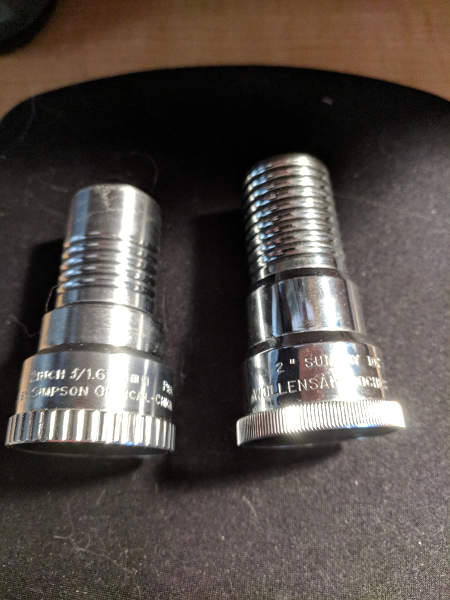
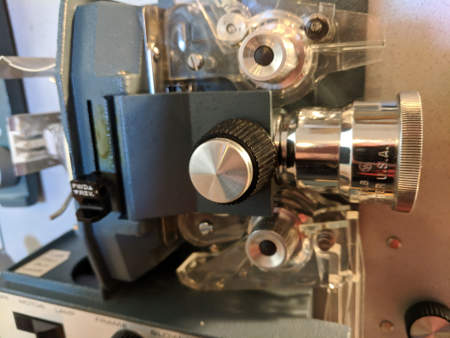
Posted by John A Reid (Member # 6577) on March 17, 2019, 02:25 PM:
Hi Janice: Thanks for checking out the 16mm Lenses on your 482 Projector. Please confirm that the insertion socket is 1"diameter?
Your 482 hinged Lens-holder seems shorter than on my 483. May be able to modify to accommodate the suggested lenses. Compare looks of 482 and 483 here: https://www.filmkorn.org/super8data/database/projectors_list/projectors_bell/projectors_bell.htm
My 483 Pics (here) show possible space constraints:
(1) 
(2)  Many thanks for your input - I will look now for similar lenses on eBay etc
Many thanks for your input - I will look now for similar lenses on eBay etc
Posted by Janice Glesser (Member # 2758) on March 17, 2019, 03:51 PM:
The B&H 483 & 482 are almost identical projectors. The 482 was marketed in 1968-69 and the 483 in 1969-1970. Other than changing the color I don't see any significant difference.
The lens holder is 1" in circumference and fits the 16mm lenses I have perfectly. The length of the 16mm lens is shorter than the original lens. You can turn the lens and position it closer or further away as necessary to focus. This is done in combination with the zoom and focus of your camera. The distance of my lens from the gate is approximately 3/4". This distance will vary slightly depending on your camera.
My two lenses came on a Keystone K-160 (2" Sunray 107 f1.6 Wollensack, Rochester, NT) & K-161(2" Keystone f1.6 - Simpson Optical, Chicago).I'm sure these are fairly standard lenses of the time and were manufactured under several brand names.

[ March 17, 2019, 06:01 PM: Message edited by: Janice Glesser ]
Posted by Nantawat Kittiwarakul (Member # 6050) on March 17, 2019, 09:10 PM:
Just to stress on Janice's point about the lens...
Short answer - most 16mm gauge projector lens with 2"(50mm) focal length will DEFINTIELY work ![[Cool]](cool.gif) ,as long as you can put it in the projector'S lens barrel.
,as long as you can put it in the projector'S lens barrel. ![[Big Grin]](biggrin.gif)
Moreover,most lens for old model 16mm projectors would have "small" barrel diameter (couldn't remember the exact size but something around 30-31mm). This makes it a perfect choice for this telecine approach. I'd tried this method with about a dozen of camcorders ranging from old Sony handycam with long 20x zoom to recent flash memory ones with shorter 10x zoom ones. ALL WORKS PERFECTLY WITH THIS LENS. ![[Big Grin]](biggrin.gif)
Posted by John A Reid (Member # 6577) on March 17, 2019, 09:30 PM:
Nantawat: Good of you to re-inforce that from your experience! Thx! Not many seen here in goodwill or Value Village outlets so I have bid for an f1.6 2"Keystone lens on eBay. Many offered seem to have scratches, fungus, or other issues. I have a 5W 24v LED on order and want to try the Sony Handycam TRV740 as is has the necessary Manual Focus etc and 15x Optical Zoom. It did a great job converting 55 old tapes from analog to digital and into PC. Unfortunately, the output Jacks are only USB 1.0 (slow) or Firewire (quite fast). I have not been able to "stream"ie re-film Super 8 direct to PC - so may have to film from gate onto tapes then transfer to PC. Other alternative is re-film with Canon EOS DSLR T6i for 1080p . . . . Any comments would be most welcome!
Posted by Nantawat Kittiwarakul (Member # 6050) on March 17, 2019, 11:10 PM:
Just noticed that you're using this Sony TRV740 camcorder. Exactly this model?
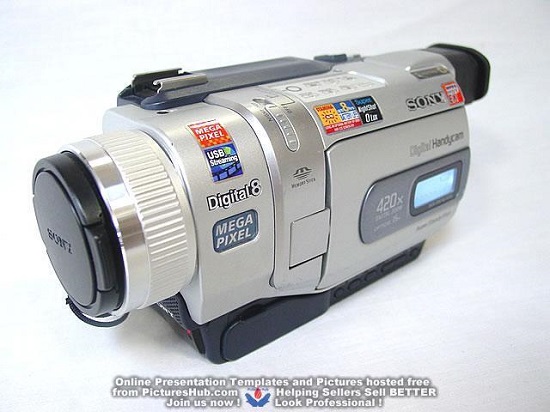
Coincidentally this is the same model that I once tried! A very decent camcorder in its day (Digital8 at its best hands down ![[Cool]](cool.gif) ). Should be enough for this job if you only want SD quality transfer.
). Should be enough for this job if you only want SD quality transfer.
A few thoughts for this method.
- Manual focus to prevent occasional focus "hunting" for no apparent reason,which happens from time to time
- Also manual exposure - better babysitting it manually than letting the auto exposure dominate,which will usually give nasty result.
- And about shutter speed - set the auto shutter function to "off" (menu>>manual set>>auto shtr>>"off"). This should lock it to 1/60 second,hence less chance of flickering.
- Then set the projector's speed to 20 fps to keep the flicker minimum. This would be quite tricky since the projector's speed control itself might drift off/fluctuate considerably during the run. Gotta keep your eyes on that.
- Unfortunately there's no manual white balance setting,it will then depend on the mercy of the camcorder's AWB (which I found to be quite acceptable). A tweak during post should be adequate for,say,Kodachrome stock.
- Capture "live" from the firewire's output - this will give the best result. ![[Wink]](wink.gif)
I've been doing film transfer as my semi-hobby job for a while. Although capturing it at SD seems quite enough for most films IMHO. Capturing old/faded/massively out-of-focus Regular8 films,for example,at full HD usually won't worth the time/hassle/effort spent.
(But yes,some customers insist on that,so I had to play along... ![[Roll Eyes]](rolleyes.gif) )
)
Posted by Phil Murat (Member # 5148) on March 18, 2019, 01:07 AM:
Hello John,
These are in French Language, however you 'll find many answers.... :
(These Websites are well structured, take your time to explore each of them)
A) Le Transfert de Pellicule
B) Le transfert de pellicule
Moreover, you will find some help for Electronic questions .....
Posted by John A Reid (Member # 6577) on March 18, 2019, 12:22 PM:
Nantawat: You are correct - I also have the Sony DCR-TRV740 (for NTSC) Thx for yr suggestions re settings!I have bid on a Keystone 2"Lens on eBay but now have to wait till bids close. Meantime, I had two more questions re the TRV740: (1) You suggest direct streaming through Firewire. Tape download to PC works fine with Firewire - but I have not found a setting to stream? Reason seems to be that on the Power Switch, the "Camera/record" is separate from "VCR/playback" Do you have a trick for simultaneous filming and streaming? (2) Sony have no suggestions for 37mm thread Macro Lenses to fit this project - I asked. Have you been able to identify such an add-on lens to suit? Thx again.
Posted by Janice Glesser (Member # 2758) on March 18, 2019, 12:32 PM:
John ... If you want to use a macro lens instead of the 16mm on the projector, you put the macro lens on your camera and remove the projector lens completely. The Raynox DCR250 Macro lens I recommended in the thread I linked above is excellent for this purpose. I believe it will fit a 37mm thread...but if not you can always use a step-up or down adapter ring on your camera. It also comes with a universal adapter that I've used with up to 52mm threads.
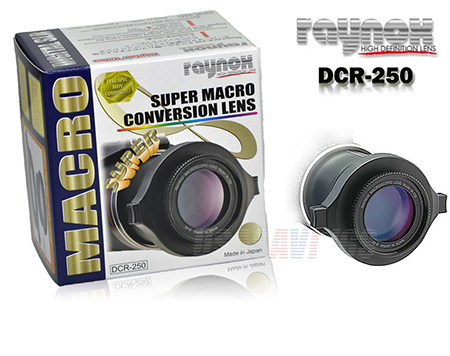
Posted by John A Reid (Member # 6577) on March 18, 2019, 04:17 PM:
Janice: The recommended Raynox 250 seems to be made for filter diameters from 52mm to 67mm. The SOny DCR-TRV 740 Digital 8 has filter diameter of 37mm. https://www.amazon.ca/Raynox-DCR-250-Super-Macro-Snap/dp/B000A1SZ2Y Will keep my pwoeder dry on this till I try the Keystone Projector 16mm lens approach .. . Thx
Posted by Janice Glesser (Member # 2758) on March 18, 2019, 09:05 PM:
My Canon also has a 37mm filter thread. As I stated already...all you have to do is buy a step-up ring to convert the 37mm up to 43mm which are the threads on the Raynox 250 macro lens. The "universal adapter" is for a minimum 52mm thread opening.
Here is how I have mine currently setup since I only could find my 37mm to 52mm step-up ring adapter:
1. 37mm to 52mm step-up ring screwed into my camera.
2. I then use the universal attachment and connect it to the 52mm ring side.
3. Then I screw the macro lens into the universal attachment which has a step-down 43mm thread opening.
If you buy a 37mm to 43mm step-up adapter you won't need the universal adapter.

[ March 18, 2019, 10:56 PM: Message edited by: Janice Glesser ]
Posted by Nantawat Kittiwarakul (Member # 6050) on March 18, 2019, 09:10 PM:
1.Capturing "live" from TRV740 is simply the same as capturing from tape. Just turn it on in CAMERA mode,you should immediately see the LIVE FEED from the camera in the capture application. That could be captured as well as from the tape,too.
2.If using the projector lens as the magnifier,you don't have to screw it onto the camera's lens. Just place it on the projector,then align it with the camera's lens as best as you can. And do the final touch up with the Zoom/focus on the camera.
Hint - before aligning the camera to the projector,you can peep into the lens with your bare eye. If you can have a bright&clear view of the film in the gate,so does your camera too. ![[Wink]](wink.gif)
Posted by Janice Glesser (Member # 2758) on March 18, 2019, 10:53 PM:
John...I found my 37mm to 43mm adapter ring. This does not require using the universal adapter. Just screw in the adapter ring to the camera and then the Raynox macro lens to the adapter. Eazy...Peazy ![[Smile]](smile.gif)
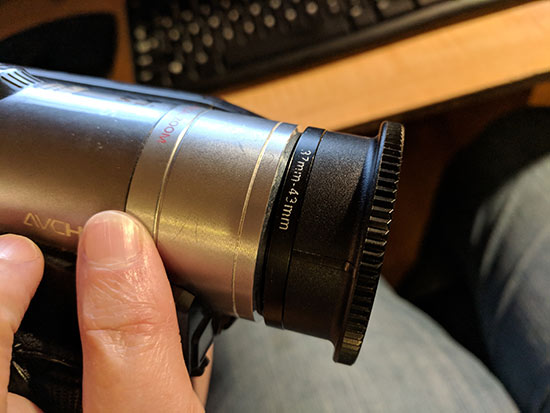
Posted by John A Reid (Member # 6577) on March 20, 2019, 10:06 PM:
Janice & Nantawat: Excellent input on camera, and lenses etc. Thx. I have a couple of eBay bids out on Keystone Lens - won't know until those close. Meantime, I am trying to select an LED setup for re-filming at the gate, back through the lens. Current thought: 5-7 Watts (dimmable). Currently have Tveden DSW-PIM-24 (plug-in 200 Watt halogen) for normal projection, but way too powerful for close work. (BTW the B&H 483 has 24vAC Lamp socket, whereas 482 has 110vAC!) Thinking of QLV-1 Lampholder but need input re selection of Transformer or Trans-rectifier 110v to 12v (since very few 24v LED lamps out there). Probably also need LED DRIVER and DIMMER. The 483 Projector has a "Room Lamp" socket on the back - convenient 110vAC source. LED Components will be external to projector - then just feed wires to new lamp base QLV-1. Spent hours on-line & calling suppliers ("Too small a project) so all comments welcomed re sources, LED lamp rating and type (for close work); Constant Current Driver & Dimmer etc
Posted by Janice Glesser (Member # 2758) on March 21, 2019, 12:41 PM:
John what you are envisioning is much too complicated for me. To get decent transfer results you don't need to go to such an extreme. I think unless you are experienced doing mechanical and electrical machine mods....I would keep it simple. To start with the Bell and Howell is not the most perfect projector to start with. Yes it does have variable speed so it's doable...but not ideal.
According to the Super 8 database (which can frequently be inaccurate) both the 482 and 483 have 120V lamps. Now varing models can be different, but my 482 is 120V. I have done a QLV-1 lamp conversion on this projector and 3 other Bell and Howells. For projection I use an ENH 120V 250W bulb. If I wanted to use the 482 to telecine off the gate I would just buy a 120V 10W or 20W halogen bulb and add a diffuser. I would control exposure with my camera... no dimmer needed. It's much easier to find low wattage halogen bulbs than compatible LED's...but more and more LEDs are coming out every day. The new LEDs have the DC/AC converters built in to the bulb. However until you find one...I'd use a halogen. You are not shooting frame-by-frame so no worries about burning the film...especially with such a low wattage bulb.
I think George Tveden sells a DIY QLV-1 conversion kit (at least he did in the past). If your lamp is 24V...then just look for a MR16 24V 10W or 20W bulb.
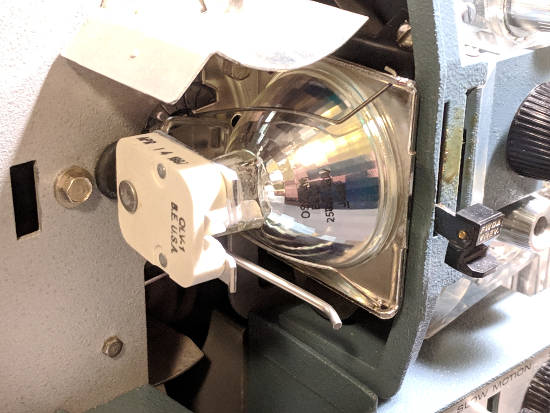
Posted by John A Reid (Member # 6577) on March 21, 2019, 01:04 PM:
Janet: My original approach was KISS! Both the B&H 482 and 483 Projectors are indeed 120vAC - BUT the original DSW LAMP on the 483 is 24vAC. Like you, I converted the lamp for normal projection with QLV-1 Base & 200 Watt Halogen (Tveden DSW-PIM-240-200) Works great! Hoped to use LED for cool telecine operation but LED hard to find for 24volts. Downside of all LED's is potential for Thermal Runaway"" ie as temperature rises resistance drops and current goes through the roof, so all suppliers suggest a Constant Current Driver (rather than Constant Voltage - not right) Since many more 12v and 110v LEd's are available than 24v - that is why I was leaning that way. As an alternative, I already bought a 24v 20W Halogen which fits QLV-1 Base so will try that with Diffuser when/if I get the Keystone Lens. Thanks for your tip/experience.
Posted by Nantawat Kittiwarakul (Member # 6050) on March 21, 2019, 08:13 PM:
I use some darn cheap 12v LED panel (2-3$ each) as the light source,and some off-the-shelf 12vdc power supply to run it. That's it,no problem so far. ![[Wink]](wink.gif)
Posted by John A Reid (Member # 6577) on March 26, 2019, 04:15 PM:
Update: Received Simpson Optical 16mm 2" Focus f1.6 Lens via eBay - but barrel is 29mm so will not fit existing Lens Carrier! (Existing Lens on B&H 483 is B&H f1.2 19-32 Zoom and 25mm (1")diameter) Clearly all these lenses do not fit this projector. I guess I need to keep looking for the Keystone-type lens . . . . .
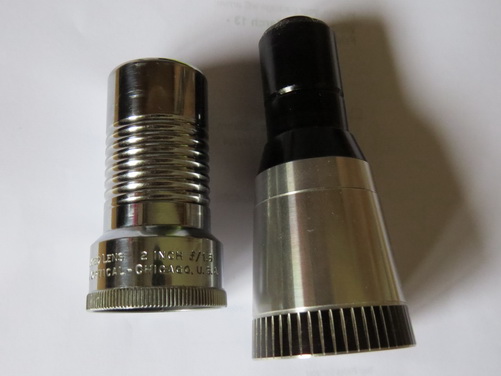
Posted by Janice Glesser (Member # 2758) on March 26, 2019, 06:53 PM:
Is the base too wide or too narrow? If too narrow just wrap black electrical tape around it. I have to do this with my one of my lenses.
Posted by John A Reid (Member # 6577) on March 26, 2019, 07:41 PM:
Janice: The old B&H 483 Projector Lens is 1" diameter at the insertion end ie smaller than the Simpson 16mm Lens which is almost 1 1/8" diameter and so cannot be inserted into the Lens Holder.
I am checking a Wollensak 2"SUNRAY on line - so keep fingers crossed . . . .
Posted by Janice Glesser (Member # 2758) on March 26, 2019, 09:16 PM:
Perhaps you can have the seller measure the dimensions. This would avoid you buying something that won't fit. The Bell & Howell is pretty unforgiving when it comes to the lens barrel size.
Posted by Nantawat Kittiwarakul (Member # 6050) on March 26, 2019, 09:56 PM:
Uh-oh, ![[Frown]](frown.gif)
You sure can insert small-barrel lens into large-barrel lens mount,but not other way round. ![[Roll Eyes]](rolleyes.gif)
Not sure which solution is easier between keeping the projector and trying to find a new smaller barrel lens,or keeping the lens and finding another dual8 projector which accepts larger lens (Sankyo name springs up into my mind now).
Posted by John A Reid (Member # 6577) on April 18, 2019, 04:02 PM:
I have fitted (Keystone) 16mm Lens as recommended by Janice into my B&H 483 Projector, and captured from Sony TRV 740 with editing software Corel VideoStudio 2019(Trial Version) Of course the 16mm/ movie camera combo is shooting "reversed" - so, using Corel, I was also able to "flip" the movie to the mirror image. Results were still a bit "fuzzy"ie unsharp even with best manual focus and exposure etc which I could obtain. From experience, what is best distance for front of Sony lens to front of Projector Lens??
Posted by Janice Glesser (Member # 2758) on April 18, 2019, 06:21 PM:
Hi John...Glad you were able to get a 16mm lens to fit your projector. As far as the sharpness of the capture remember you are doing "realtime" capturing. Even shooting off the gate it will never be as sharp as frame by frame scanning. However, I started out doing realtime capturing and got very acceptable results using post capture software enhancements. If Corel Video Studio has sharpening tools you can try to see if that helps. One of the best software for degraining and sharpening software is NeatVideo https://www.neatvideo.com/overview/what-is-it. . NeatVideo has a plugin filter for VirtualDub2 https://sourceforge.net/projects/vdfiltermod/. I recommend using VirtualDub2 (it can reverse your captured footage...adjust the framerate... and you can load other enhancement filters besides NeatVideo. VirtualDub is free, but NeatVideo is not. VirtualDub2 can import multiple video file formats...whereas original VirtualDub will only import AVI files.
There is no set distance paramenters I can give you since it all depends on your projector lens and your camcorder lens. You just need to adjust one or both to get the sharpest image you can. Make sure you are not using digital zoom.
[ April 18, 2019, 07:50 PM: Message edited by: Janice Glesser ]
Posted by Nantawat Kittiwarakul (Member # 6050) on April 18, 2019, 08:47 PM:
With the camera away,can you look into the lens and see the "magnified" image of the film there? Is it sharp/bright/clear to your eyes? If yes,it is the camcorder's settings that is still somewhat "off" I guess. ![[Wink]](wink.gif)
BTW I'm about to do a customer's S8 transfer job tonight or tomorrow. May post the picture of my setup for your reference,too. ![[Smile]](smile.gif)
Posted by John A Reid (Member # 6577) on April 30, 2019, 01:54 PM:
Tests re-filmng with (a) Sony DCR-TRV 740 and (b) Canon DSLR EOS Rebel T6i show latter is better quality (more control ie ISO, WB, focus, shutter etc).
Used 24v 20W Halogen Reflector Lamp in QLV-1 Holder on B&H 483 Projector.
Avoided "hotspots" (temporarily!) with glass plate (old picture frame) and three sheets of white paper.
Would welcome any suggestions re better diffuser between halogen lamp and gate? (ground glass?)
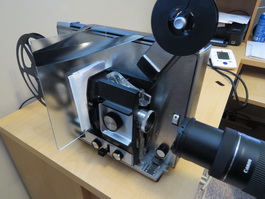
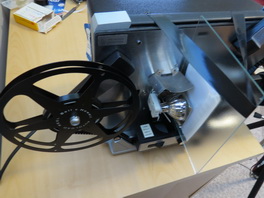
Posted by Buck Bito (Member # 2676) on April 30, 2019, 07:54 PM:
Opal glass is what we used back when we ran film-chains:
https://www.edmundoptics.com/f/opal-diffusing-glass/11914/
It looks like there is now a cheaper option called White Diffusing Glass, but I have no experience with it:
https://www.edmundoptics.com/f/white-diffusing-glass/15084/
Posted by Janice Glesser (Member # 2758) on April 30, 2019, 09:16 PM:
I DIY'd a diffuser which I used in my 16mm projector. I got the idea from this YouTube video:
https://youtu.be/z7c9aKA301U
I just insert the diffuser into the front of the lamp.
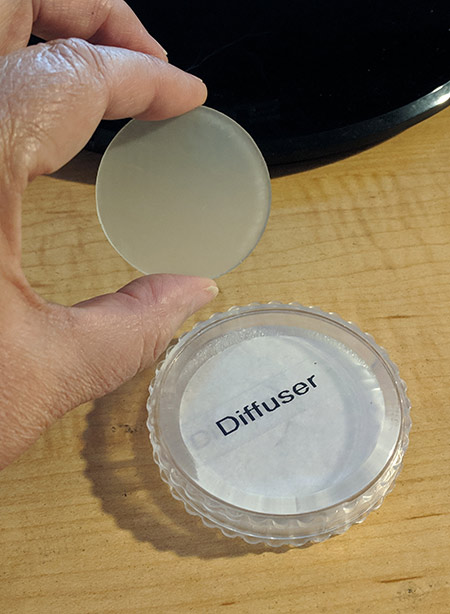
Posted by Nantawat Kittiwarakul (Member # 6050) on April 30, 2019, 10:04 PM:
I uses 2 layers of tracing paper as diffuser. ![[Big Grin]](biggrin.gif) Works perfect for me.
Works perfect for me.
Posted by John A Reid (Member # 6577) on June 13, 2019, 04:37 PM:
Update: (Almost) acceptable results achieved now re-filming 50-yr old Super 8 in B&H 483 Projector with Canon T6i DSLR. Changed Lamp to 110v/7Watt LED on angle bracket with Dimmer, with 1/8" sheet of opaque poly(UHMWPE) as condenser between lamp and gate. Final problem - projector speed control! Many tests with various f numbers, definition settings, shutter speeds, at 30p as well as 60p - annoying strobe "shadow" moves up or down screen due to unpredictable slight projector speed variation. Need precise control of motor speed (electrically). Does anyone know what motor type is in B&H 483 (1965)? If synchronous motor - I am told it is tricky/expensive to control. If other - maybe speed control (with feedback) is possible? Would love to hear about this.
Posted by Janice Glesser (Member # 2758) on June 14, 2019, 12:00 AM:
John... I haven't measured my B&H variable speed projector for max speed. The non-variable speed models max out at 18 fps. If your projector is only running at 18 or 19 fps when dial is at max speed... then this would definitely cause banding (rolling gray bars). You need 20 fps to sync with your camera. I use a digital tachometer to measure the rpm of the shutter.
Posted by John A Reid (Member # 6577) on June 14, 2019, 01:21 AM:
Janice: Thx - the narrow dark band moves down the screen when the speed control is too low, and when more speed, the band moves up the screen - but never disappears.
(1) Are you measuring the speed at the motor, the hand-operated knurled wheel at the front of the Projector, near the lens? or what? (2) Can you recommend a usable/appropriate tach?
Thx again for prompt reply. PS Several other tinkerers have added electrical speed control to stabilise the film speed, since the split pulley vee-drive is imprecise and speed varies. Synchronous motors are hardest to control. DC are relatively easy. I have not been able to determine what type of motor is in the B&H 483. Web source shows Motor as "magnetic". Service Manual refers only to "Motor Assembly" . . .
Posted by Janice Glesser (Member # 2758) on June 14, 2019, 03:20 AM:
John - The Super8 database says that the motor on the 483 is DC...however the databse is not always accurate.
You need to measure the rotating 3-blade shutter - not the fan. It's the Frames Per Second you are measuring since that is the image rate being captured by your camera.
Take a look at this thread. It has a picture of the tach I bought and explains the process.
http://8mmforum.film-tech.com/cgi-bin/ubb/ultimatebb.cgi?ubb=get_topic;f=1;t=009387
[ June 14, 2019, 11:44 AM: Message edited by: Janice Glesser ]
Posted by Janice Glesser (Member # 2758) on June 15, 2019, 08:56 PM:
Hi John...I decided to check out the speed range on my B&H 482. I'm no expert at this and my tachometer is NOT an expensive meter and may not be completely accurate. That said I have used it to calibrate my sound projectors with good results. However, telecine is a little more exacting when it comes to frame rate synchronization. It's best if your projector speed can run faster than 20fps so you have more variance in adjustment.
I measured the shutter speed with the slow motion switch turned off and only turning the rheostat speed control knob:
Lowest speed 14.83 fps
Highest speed 19.83 fps
If I were to try to use this projector for telecine...without a special shutter speed adjustment feature on my camcorder...I would probably get flicker or banding just as you are experiencing.
I know this may not be what you wanted to hear...but I've never used this projector for film transfers. The projectors I've used such as the Sankyo 2500H, the Chinon 727 Whisper, the Bell & Howell 11XJ and the Chinon 4000GL all had variable speeds ranging from 14-22fps.
Maybe your speed measurements will be more accurate than mine with more promising results.
[ June 17, 2019, 10:20 AM: Message edited by: Janice Glesser ]
Posted by John A Reid (Member # 6577) on June 16, 2019, 02:22 PM:
Janice: Thanks for doing that test - though results are not too promising! Should have my new Tach by Tuesday - have to drive to US to pick it up - then we'll see. If speed is actually below 20 fps, then I may have to change drive arrgt on B&H 483. Possibly can achieve a higher output speed to shutter disk by replacing "belt" (O-ring) with thicker one, which would force belt out to larger radius on split-vee motor pulley . . . Ultimately I would like speed control to be more constant than this motor can provide. Clearly this design it was good enough for projection -but "wanders" out of synch for telecine. Other 8mm threads have suggested eg sewing machine motor. Your source suggested motor is DC. Mine suggested it is "magnetic" I need a source to define what type of motor is in the B&H 483? Any ideas?
Posted by Janice Glesser (Member # 2758) on June 16, 2019, 03:52 PM:
John...Here is the 8mm Database listing for the B&H 483. Unless it's a misprint...it describes the motor as DC Magnetic. If this is correct then it's not an either/or requirement.
Bell & Howell Autoload
marketed in 1969-70
design: 483A
super 8 mm film
lens: f: 1.2 \ F: 19-32 mm
lamp: 250 W, 120 V, DLH
light settings: bright, normal, low
reel capacity: 120 m
projection: forward, reverse, still
projection speed: normal and slow motion, variable
variable speed control: by rheostat
film loading: automatic threading
manual unloading: possible
sound: no
film cutter: yes
motor: DC magnetic motor
power source: 120 V AC, 60 Hz
weight: ?
dimensions: ?
made in Usa by Bell & Howell
[ June 16, 2019, 06:21 PM: Message edited by: Janice Glesser ]
Posted by John A Reid (Member # 6577) on June 16, 2019, 05:19 PM:
Janice: Thanks again - but very confusing.
It would be nice if the motor was universal or DC - simpler control.
BTW, I found this on the Forum:
http://8mmforum.film-tech.com/cgi-bin/ubb/ultimatebb.cgi?ubb=get_topic;f=1;t=008956
I have sent a private message to Joe - so hope he is still around
Posted by Nantawat Kittiwarakul (Member # 6050) on June 16, 2019, 07:30 PM:
Simply put - that the curse of CMOS sensor camera. You'll ALWAYS get some banding as the result,and there's nothing much you can do with that.
And the bad news - most (if not all) of today's camera/camcorder uses CMOS sensor,period. ![[Frown]](frown.gif)
This is the reason I still retain my good'ole Panasonic GS400 as my workhorse. A good top end SD consumer,with 3CCD sensors,hence no banding at all. ![[Big Grin]](biggrin.gif)
Posted by John A Reid (Member # 6577) on June 16, 2019, 10:15 PM:
Janice: Nantawat makes an excellent but disappointing point re CCD better than CMOS sensor with "rolling shutter" whereas CCD cameras often have global shutter - so no banding problem. Maybe I made a big mistake using Canon T6i with CMOS . . . ?
Comments welcomed.
Posted by Janice Glesser (Member # 2758) on June 16, 2019, 11:37 PM:
The CMOS vs CCD was going to be my next post, but Nantawat beat me to it ![[Smile]](smile.gif) . Not all CMOS sensors produce visable banding. I use a Canon Vixia HV40... a HF200, and a HF20 (all have CMOS sensors) with no banding issues as long as the projector runs at the correct speed for syncing. However, the CMOS image sensors are much smaller on the camcorders versus the sensor on the T6i camera. The rolling shutter with the larger sensor might make the banding more prominent (I don't know if this is the case or not), but you first need to make sure your projector is running at a correct syncing speed before you can determine the CMOS is definitely causing the banding.
. Not all CMOS sensors produce visable banding. I use a Canon Vixia HV40... a HF200, and a HF20 (all have CMOS sensors) with no banding issues as long as the projector runs at the correct speed for syncing. However, the CMOS image sensors are much smaller on the camcorders versus the sensor on the T6i camera. The rolling shutter with the larger sensor might make the banding more prominent (I don't know if this is the case or not), but you first need to make sure your projector is running at a correct syncing speed before you can determine the CMOS is definitely causing the banding.
[ June 17, 2019, 02:10 AM: Message edited by: Janice Glesser ]
Posted by Nantawat Kittiwarakul (Member # 6050) on June 17, 2019, 03:29 AM:
And Janice just made the BIG point. ![[Wink]](wink.gif)
If you can tune in the projector to the EXACT sync speed,the banding should be minimized.
Tried that with my camcorder (Canon legria hf-g30) by setting at 25p node,with 1/25 second shutter speed. Running the projector at precisely 16.67 fps to give least amount of banding.
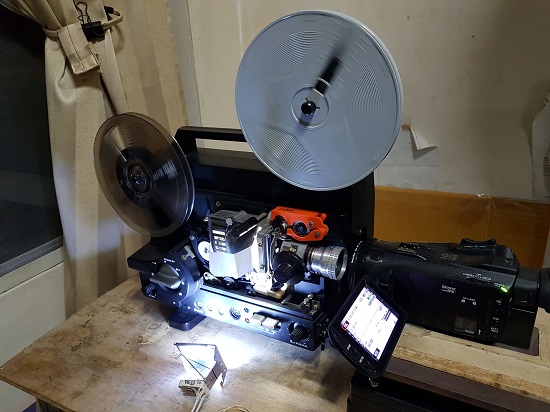
The result is quite good,the banding is still there but barely noticeable. Only when the speed is waaaay off the sync that the banding will be prominent again.
But since you're living in NTSC world,your sync speed&correct camera settings will be different from me of course.
Visit www.film-tech.com for free equipment manual downloads. Copyright 2003-2019 Film-Tech Cinema Systems LLC

UBB.classicTM
6.3.1.2




![[Cool]](cool.gif) ,as long as you can put it in the projector'S lens barrel.
,as long as you can put it in the projector'S lens barrel. ![[Big Grin]](biggrin.gif)
![[Big Grin]](biggrin.gif)

![[Cool]](cool.gif) ). Should be enough for this job if you only want SD quality transfer.
). Should be enough for this job if you only want SD quality transfer.![[Wink]](wink.gif)
![[Roll Eyes]](rolleyes.gif) )
)


![[Wink]](wink.gif)
![[Smile]](smile.gif)


![[Wink]](wink.gif)
![[Frown]](frown.gif)
![[Roll Eyes]](rolleyes.gif)
![[Wink]](wink.gif)
![[Smile]](smile.gif)

![[Big Grin]](biggrin.gif) Works perfect for me.
Works perfect for me.
![[Frown]](frown.gif)
![[Big Grin]](biggrin.gif)
![[Smile]](smile.gif) . Not all CMOS sensors produce visable banding. I use a Canon Vixia HV40... a HF200, and a HF20 (all have CMOS sensors) with no banding issues as long as the projector runs at the correct speed for syncing. However, the CMOS image sensors are much smaller on the camcorders versus the sensor on the T6i camera. The rolling shutter with the larger sensor might make the banding more prominent (I don't know if this is the case or not), but you first need to make sure your projector is running at a correct syncing speed before you can determine the CMOS is definitely causing the banding.
. Not all CMOS sensors produce visable banding. I use a Canon Vixia HV40... a HF200, and a HF20 (all have CMOS sensors) with no banding issues as long as the projector runs at the correct speed for syncing. However, the CMOS image sensors are much smaller on the camcorders versus the sensor on the T6i camera. The rolling shutter with the larger sensor might make the banding more prominent (I don't know if this is the case or not), but you first need to make sure your projector is running at a correct syncing speed before you can determine the CMOS is definitely causing the banding.![[Wink]](wink.gif)
